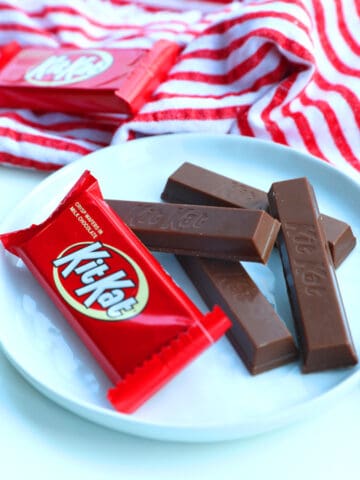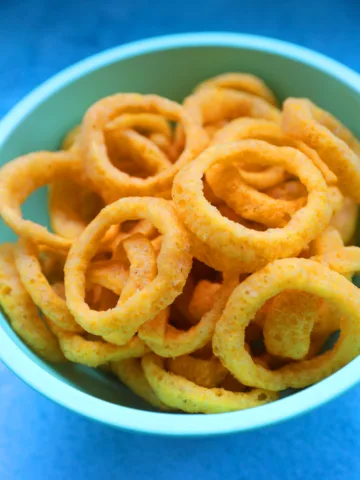It’s crunchy, chocolately, and has a distinct peanut butter flavor. But is Butterfinger gluten free? Or do you need to find a different fix for your candy cravings if you’re on a gluten-free diet?

Butterfingers come in all shapes and sizes, from the original bar to Butterfinger Baking Bits to Butterfinger Dessert Toppers.
The original Butterfinger and many variations are gluten-free, as they contain only gluten-free ingredients.
But there are a few types of the popular candy bar that are not compatible with a gluten-free diet. Read on to find out more.
Jump to:
What is a Butterfinger candy bar?
The original Butterfinger bars were invented by the Curtiss Candy Company in the early 1920s. The sweet treat had a crispy peanut-butter interior, covered in milk chocolate. Soon, it became one of their best-selling products.
Fast-forward about 60 years, and in 1981 Nabisco bought Curtiss Candy. Then Nestle purchased the brand a few years later. They started to develop various Butterfinger products in different sizes and shapes, along with special holiday varieties for Christmas, Easter. and Halloween.
In 2018, Nestle sold the brand to candy company Ferrero, makers of the Ferrero Rocher chocolates, among others. Now the company produces more than 1.6 billion Butterfinger chocolate bars each year.
What’s in a Butterfinger?
Though the original recipe for Butterfingers was lost when Nabisco acquired the brand in the 1980s, the recreated one is very similar.
The basic components still comprise the candy bar, namely the flaky peanut butter middle and a chocolate coating.
That crispy interior is made from creamy peanut butter that’s mixed with confectioner’s corn flakes. Not the breakfast cereal, but actual flakes of corn, which help produce a flaky, crunchy texture. It’s then mixed with sugar and other ingredients to produce a melted, soft version of the candy’s interior. Once it cools, it crystallizes and becomes crunchy.

Main ingredients in a Butterfinger include corn syrup, sugar, peanuts, vegetable oil, peanut flour, milk, cocoa, salt, soy lecithin (an additive that helps process fats in the body), natural flavor, and annatto color (an orange-red food coloring), as well as soy products.
According to the nutrition label, a 1.9 oz Butterfinger bar contains 250 and 21 grams of sugar.
Do Butterfingers contain gluten?
Several types of Butterfinger candy bars are gluten free, as most of the product variations are simply different sizes of the original — and they have no gluten-containing ingredients.
But some kinds, mostly seasonal products, do have gluten. Below is a list of the gluten-free varieties, as well as those with gluten ingredients.
Gluten-free Butterfingers
- Butterfinger (original 1.9 oz candy bar)
- Butterfinger Share Pack
- Butterfinger Fun Size
- Butterfinger Bites
- Butterfinger Minis
- Butterfinger Baking Bits
- Butterfinger Dessert Toppers
- Butterfinger Cups
Butterfingers that are not gluten free
These Butterfinger flavors are not considered gluten free, as the ingredients list indicates they may contain wheat or wheat flour.
- Butterfinger Skull
- Butterfinger Nesteggs
- Butterfinger Hearts
- Butterfinger Medallions
- Butterfinger Crisp
- Butterfinger Giant Bar
- Butterfinger Snackerz
So if you have Celiac disease, a gluten allergy, or other gluten intolerance or gluten sensitivity, you want to avoid eating one of these Butterfinger varieties.

FAQ
Unopened Butterfingers have a shelf life of around 10 months. Your product label will have a best-by or expiration date which will indicate how long your bar will maintain peak freshness. It’s best to store them in a cool, dry area like a pantry or cupboard.
More gluten-related answers
Find out whether more of your favorite foods contain gluten or not. Check out the posts below.






Leave a Reply